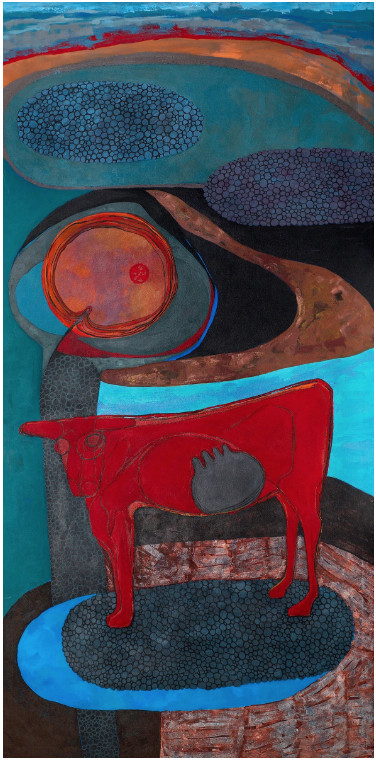Leo Robinson first solo exhibition in the UK
05/07/2019 - 13/09/2019Theories for Cosmic Joy

Tiwani Contemporary presents Theories for Cosmic Joy, Leo Robinson’s first solo exhibition in the UK. Leo Robinson (b.1994) is a multi-disciplinary artist who graduated from Manchester School of Art in 2016. He is also the founder and singer-songwriter behind Cult Party, a Manchester-based band noted for music that combines pastoral folk with experimental lyricism. His artistic practice runs parallel to his explorations in spirituality, self discovery and folklore. His work begins from meditations upon his own attachments and ideals, before questioning how they mirror the wider external human world. Robinson’s visual symbols range from the deeply personal to the referential, scientific and historical. His current body of work presents the prophecies of a society split into frenzied technophiles and naturalist-purists, exploring ideas related to capitalism, the internet and environmentalism.
Theories for Cosmic Joy showcases new, previously unseen work developed by Robinson over the past two years. Robinson produces diverse and symbolically rich work, spanning drawing, collage, watercolour, sculpture and video. The exhibition focusses on works on paper which illuminate the philosophical and mystical explorations of his practice.

In his work, Robinson narrates the origin stories and founding myths of a fictional micro-civilisation, whose knowledge, beliefs, art, morals and customs echo real-world cultural constructs. This world-building exercise allows the artist to explore and critique fundamental ideas relating to the blocs of thinking that make up civilisation, such as progress, religion and aesthetics. Referencing Plato, and the birth of conceptual thought, Robinson is interested in studying how humans deal with the prospect of transformation through abstract belief formation, and observes the human tendency to cling to ideas with the expectation of transcendental or transformative outcomes.
“Both the desire to indulge in abstraction and to cleanse oneself of it are presented on equal terms, as a constant battle between two extremes. The extreme dualities that exist not only in the mind but in external circumstances, such as current socio-political conflicts and religious debate also played a part in the conflict that exists within the work.”
Leo Robinson
The works on paper in the exhibition are inspired by folk-tale illustrations, scientific drawings, illustrated teaching books and the visionary work of William Blake. In Newton with Horse Christ (2019), Robinson pays homage to William Blake’s portrait of the English scientist. Echoing the original watercolour, which questioned the relationship between science and religion, Robinson’s Newton is depicted following the rules of his compass, seemingly oblivious to his surroundings. Meanwhile a black horse, a symbolic deity whose thigh is tattooed with a cross, stands besides him. Technology and science often feature as tangible, propelling forces within Robinson’s fictional world, and recurring elements, such as grids and surreal machines, which are analogous to pixels or nets, attempt to capture and abstract the world from its sensible reality. The artist often counterbalances the propelling forces of progress with their opposites: thus a society which worships technology is also embattled in violent and recurring ideological clashes with obscurantist, anti-science and anarcho-primitivist factions.
Presenting such oppositions is a way for the artist to explore the Buddhist concept of the ‘middle way’ or moderation, a path which reconciles or transcends the duality between asceticism and indulgence.




